Sep 17, 2019 | Alumni, IIASA Network
Monika Bauer, IIASA Network and Alumni Officer, interviewed alumnus Dennis Meadows during his recent visit to IIASA.
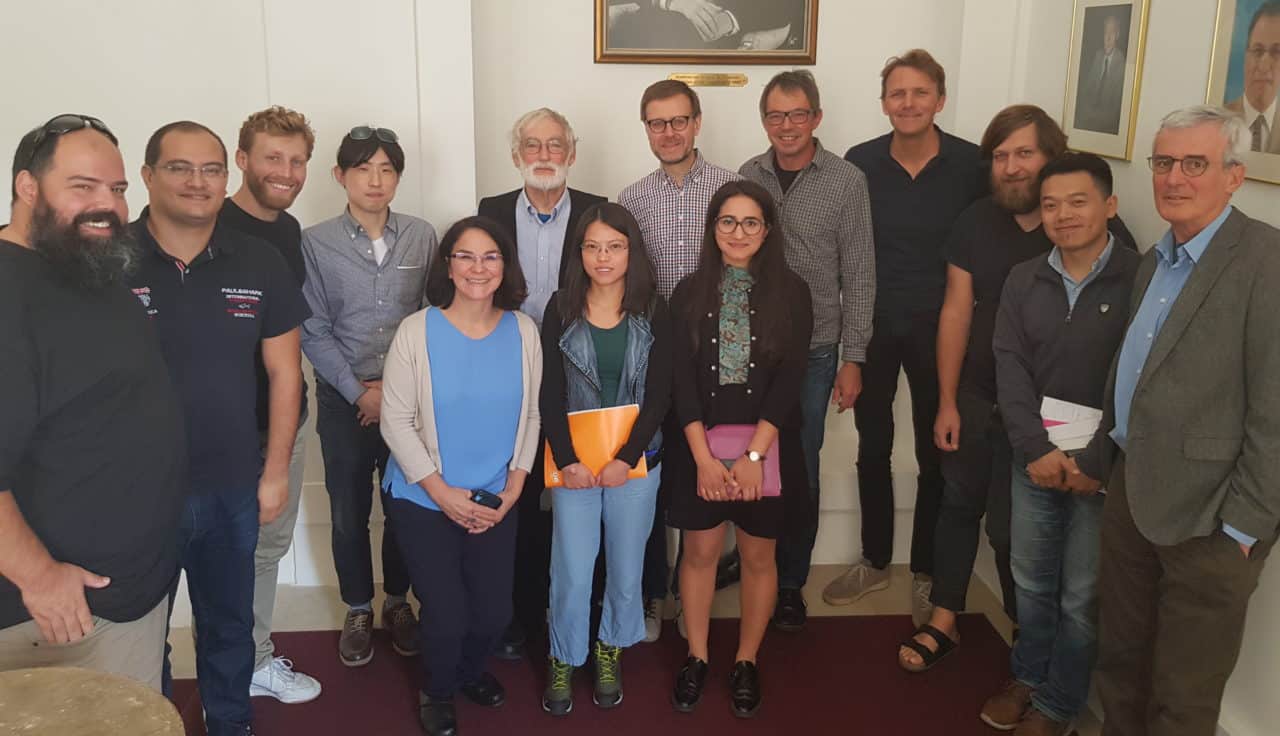
Dennis Meadows with colleagues in the IIASA Water & RISK Programs © Monika Bauer | IIASA
“It’s a great pleasure to be back at IIASA because the institute really had a big impact on my professional life,” said Dennis Meadows, coauthor of the seminal book Limits to Growth, after his lecture to IIASA staff during a recent visit to the institute. “I came to IIASA, and it gave me so many new ideas and contacts. It became the fuel for my professional activities for a long time.”
Meadows visited the IIASA Energy Program in 1977 when Roger Levien was director, and he says that Levien greatly impacted the way he viewed problems. In his lecture titled, Lessons from 50 years of model-based policy advocacy, he pointed out that Levien looked at problems as universal or global, and that he uses the criteria Levien passed on to him in what he calls “problem selection” to this day. Meadows also spent some time at the institute from 1983-1984 when C.S. Buzz Holling was director.
During his lecture, Meadows highlighted the idea of using the concept of an “invisible college” as a strategy to implement academic work. He explained that an “invisible college” usually constitutes a group of about 50 people connected with an issue, who, while they do not necessarily all have to agree on the issue or do the same work, can collectively come up with a solution.

© Dennis Meadows
Meadows created his version of an invisible college through the Balaton Group, a global network for collaboration on systems and sustainability that he founded in 1982. He says that the network is meant to “connect and empower people who will go back home and do good things”. Meadows stopped by IIASA on his way to the group’s annual retreat in at Lake Belaton in Hungary, where 50 leading scientists, teachers, consultants, writers, and managers annually get together to discuss topical issues on their own costs. According to Meadows, this in itself shows the value individuals see in the meetings. The results of past meetings are outlined on the group’s webpage.
When asked about his key messages for IIASA, Meadows’ answers focused on the institute’s alumni network and exploring a deeper understanding of resilience.
“The incredible power of IIASA lies in its alumni, rather than in its models. You create the alumni network through the process of creating models. IIASA doesn’t have many models, but it has thousands of alumni. One of the first things I would look at is how to link alumni more strongly together, so they could help each other. I still have affection for the institute and respect for what it does, and I’m sure that my opinion is shared by many.”
His second take-away for IIASA concerns building a deeper expertise on resilience. “Sustainable development is something that is hard to realize, while there is no doubt that shocks will continue to occur, and there is no unified theory in resilience yet. In my opinion, IIASA has an opportunity to tap into a huge legacy of understanding that goes back to Buzz Holling’s work.”
Note: This article gives the views of the author, and not the position of the Nexus blog, nor of the International Institute for Applied Systems Analysis.
Aug 8, 2019 | Data and Methods, Economics, IIASA Network, Russia
By Serguei Kaniovski, Economist with the Austrian Institute of Economic Research (WIFO)
Serguei Kaniovski and colleagues from IIASA and the Steklov Mathematical Institute of the Russian Academy of Sciences revisited a classic growth model in resource economics using recent advances in optimal control theory.
The late 1960s and early 1970s gave rise to Doomsday Models that predicted a collapse of Western Civilization under the pressure of over-population and environmental pollution. The very influential 1972 Club of Rome’s report on the “Limits to Growth” painted a gloomy picture, sparking an ongoing debate. One question was whether the scarcity of natural resources like fossil fuels would limit growth and cause a substantial decline in people’s standard of living.
The Doomsday reasoning was met with doubt by the economists of that time, leading the future Nobel Prize laureate and growth theorist, Robert Solow, to state that “the various Doomsday Models are worthless as science and as guides to public policy“. In a combined effort, economists developed a class of growth models with resource constraints. The conclusions they reached using the Dasgupta-Heal-Solow-Stiglitz (DHSS) modeling framework offered a more optimistic outlook.

© Kantver | Dreamstime.com
Economic applications have been well ahead of the mathematical theory used for identifying optimal economic policies, leaving some model solutions unexposed and some technical issues unsettled. The theory that allows us to identify optimal policies and describe the model dynamics was originally developed in the 1950s for engineering applications but has since become the main tool for analyzing economic growth models. These models however contain many features that are not standard to optimal control theory – a subfield of mathematics that deals with the control of continuously operating dynamic systems – which makes a fully rigorous analysis difficult. The key theoretical challenges are infinite planning horizons and nonstandard control constraints.
In our latest paper we offer a complete and rigorous analysis of the welfare-maximizing investment and depletion policies in the DHSS model with capital depreciation and arbitrary (decreasing, constant, and increasing) returns to scale. The investment policy specifies the portion of the final output to be invested in capital. A depletion policy says how fast a finite stock of exhaustible resources should be used. We prove the existence of a solution and characterize the behavior of solutions for all combinations of the model parameters using necessary rather than sufficient (Arrow’s theorem) optimality conditions.
In the main case of decreasing, constant, or weakly increasing returns to scale, the optimal investment and depletion policies converge to a constant share of output invested in capital and a constant rate of depletion of the natural resource. The optimal investment ratio decreases with the longevity of capital and impatience. The relationship between the optimal investment ratio and the output elasticity of produced capital is ambiguous. The performed analytical analysis identifies those relationships among model parameters that are critical to the optimal dynamics. In this, it differs from more conventional scenario-based approaches. From a practical point of view, application of the model to real data could be helpful for evaluating actual depletion and investment policies.
Strongly increasing returns to scale make it optimal to deplete the resource without investing in produced capital. Whether a zero-investment strategy is followed from the outset, from an instant of time, or asymptotically will depend on the sizes of the capital and resource stocks. In some special cases of increasing returns, welfare-maximizing investment and extraction policies may not exist under strong scale effects in resource use. This occurs when an initial stock of capital is small relative to the initial resource stock. It implies that it would have been impossible to formulate a welfare-maximizing policy in the early history of humanity, when produced capital was scarce and resources were abundant.
Reference
Aseev S, Besov K, & Kaniovski S (2019). Optimal Policies in the Dasgupta—Heal—Solow—Stiglitz Model under Nonconstant Returns to Scale. Proceedings of the Steklov Institute of Mathematics 304 (1): 74-109. [pure.iiasa.ac.at/15946]
Note: This article gives the views of the author, and not the position of the Nexus blog, nor of the International Institute for Applied Systems Analysis.
Jul 31, 2019 | Alumni, IIASA Network, India, Women in Science
By Nandita Saikia, Assistant Professor of Population Studies at Jawaharlal Nehru University, New Delhi, and former postdoctoral researcher at IIASA
IIASA alumna Nandita Saikia, looks back on the two years that she spent living in Austria while working as a postdoctoral researcher in the World Population Program.
The submission of my PhD thesis, marriage, taking up a university position, and becoming a mother, all happened rather quickly for me. By the time I realized that I wanted to experience working outside of my own country, a good five years had flown by from the day that I received my PhD. For a female academic, who is trying to balance family and work, a decision to move abroad was never going to be easy. It needed a lot of planning, not only in terms of the research topic that I wanted to pursue, but also in terms of organizing things in a way that would lead to the least disruption for the research students I was supervising and of course, my family.
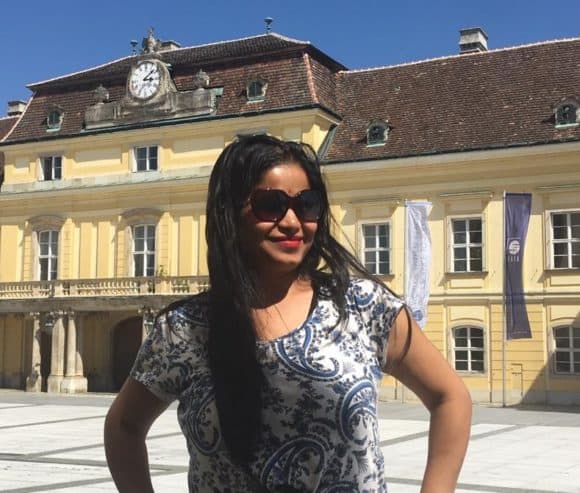
Nandiita Saikia | © Nandita Saikia
With little hope and many conditions, I searched for postdoctoral positions on the websites of various institutes. I was amazed when I found an advertisement for a postdoc position at IIASA, which mentioned that it had extended application deadlines for another 18 months – specifically to accommodate female candidates on maternity leave. This gender sensitive rule made my application possible, and ultimately gave me a rich experience and memories that I will cherish forever.
Looking back at the past two years at IIASA, a long list of reasons why this was such an amazing time of my and my family’s lives, comes to mind. The institute is housed in a beautiful two hundred and seventy five year old castle in Laxenburg just outside of Vienna. As an IIASA employee, my family and I could access the green imperial park once meant for Austria’s iconic empress Sissi, at any time. Apart from massive, century old trees that may have shaded Sissi on her own visits, the park contains a spring, a waterfall, and a lake with numerous monuments to Austrian royal families that frequented it over the centuries. The lush green trees, the musical sound of the spring, together with chirping wild ducks and swans, the Laxenburg castles, the tall yellow church under the deep blue sky – all constantly stimulated the spirit of a nature lover like me.
In terms of the more practical aspects of working at IIASA, staff from administration were always available to address all our personal and professional issues efficiently and warmly. We were supported with everything from extending our visas, finding a suitable place to live, and communicating with my son’s school in German, to locating the right physician. The IIASA Communication Department also helped me to convey the meaning of my research in “non-technical language” to a wider audience, for whom the findings are ultimately meant.
The soul of IIASA is truly international and inter-disciplinary. From North to South, East to West, I met colleagues from all parts of the world. The overall research environment is conducive to doing quality research. Our program director, Wolfgang Lutz, extended all possible support for me to stay at IIASA for two years. I however still had enough freedom to manage my responsibilities in terms of the supervision of my PhD students back in India.
IIASA always encourages its employees to be active and fit and supports them to do this in numerous ways. There are a number of clubs and activities on offer, including yoga, a music club, a running club, a swimming club, cycling, German lessons, aerobics, and a tennis club. The institute also maintains a gym for staff members. Some of my colleagues even kept workout clothes in the office for when they could manage to participate in some of these activities amidst their busy schedules. Although it was of course not possible to be in all the clubs, you had a choice, which contributed to the overall “feel good” environment. Being an international research organization, IIASA celebrates the different cultures of its staff members by organizing themed social gatherings like Asia Day, Latin American Day, Canada Day, and Mediterranean Day, to name a few, during which staff have the chance to taste authentic homemade cuisines and see cultural music or dance performances by colleagues. My heart knew no bounds when I got a chance to perform a Bollywood number and an Indian folk dance with my international colleagues!
I also developed an affinity with the IIASA Women in Science Club, which often organized “Meet, Greet and Eat” sessions during which we had the opportunity to interact with established women scientists in an informal way. It was indeed an eye opener to learn about how they overcame common challenges either in their early or later careers.
During our stay, we fully experienced life in Vienna, which has repeatedly been ranked as the best city in the world to live in. The centrality of Vienna also helped us to explore many neighboring countries. In our second year, we lived in Laxenburg where we felt very much at home. We loved how smoothly the little town runs while offering everything needed for a high quality life when raising young children.
Our time at IIASA was extremely productive, but we still felt as if we were in Vienna for a two-year long vacation! If someone asks me whether they should consider IIASA for a post doc or the Young Scientists Summer Program, my answer will be: “Yes, don’t even think twice!”
Nandita Saikia was a postdoctoral researcher at IIASA from 2017 to 2019. More information available at www.nanditasaikia.com.
Note: This article gives the views of the author, and not the position of the Nexus blog, nor of the International Institute for Applied Systems Analysis.
Jul 11, 2019 | IIASA Network, USA, Women in Science
Rachel Potter, IIASA communications officer, interviews retired NASA Astronaut and Principal of AstroPlanetview LLC, Sandra H Magnus on insights about our world she has gained from her time living on the International Space Station.

©NASA Photo / Houston Chronicle, Smiley N. Pool
Q: Can you tell us a bit about your specific areas of research as a scientist?
A: My PhD was on a new material system being investigated for thermionic cathodes, which are used as electron sources for satellite communication systems. My research was an effort to look at the system methodically and from a science viewpoint to understand physically what was going on in order to inform the design of more robust devices. If you can operate the cathode at a lower temperature, that means a longer life for it, which is a good thing for satellites! Post-PhD I was however admitted to the Astronaut Office and that, quite frankly, pretty much put an end to my career as a researcher, or at least as a principal investigator (PI). The work I did on the International Space Station was at the direction of other PIs who had proposed, and been granted, experiments in space.
Q: Your career has spanned a wide range of settings from the NASA Astronaut Corps to your current role as Principal of AstroPlanetview LLC – what is the common thread or focus that has run through your work?
A: Following my curiosity and looking for challenges. I always want to be challenged and feel that I am learning new things. If I feel that I have become stagnant, I start looking for how to change that situation.
Q: What have been the personal highlights of your career?
A: Clearly flying in space! I feel very fortunate, however, to have been in the Astronaut Office during the era of the space station. I enjoyed very much working in a collaborative, multicultural, international environment where we had a big team of people from around the world working on something that benefits the planet.
Q: What are the greatest lessons you have learned from seeing the Earth from space?
A: I was so excited to FINALLY be going into space after hoping to do just that for over 20 years. The Earth is our spaceship – a closed system in which everything on the planet affects, and is connected to everything else on the planet. An action somewhere means a reaction somewhere else, even if it is not always first order (and usually it is not). Also, the planet looks incredibly beautiful and very fragile – we have to take care of it!
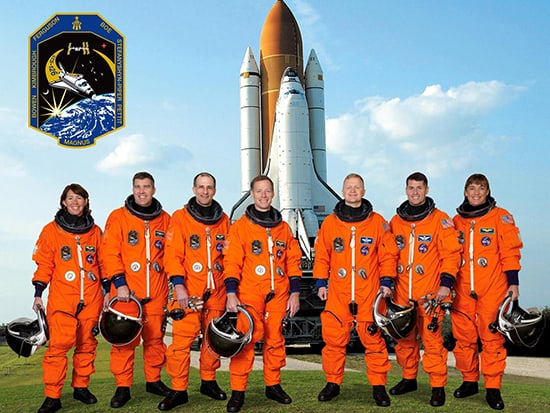
© NASA STS-126 Shuttle Mission full crew photo (5 March 2008), Sandra H Magnus far left.
Q: What do you see as key to solving the complex problems the Earth faces in terms of sustainability?
A: Having the will to do it as a community. If you have the will, commitment and a clear, agreed-to, articulation of the common goal, we can pretty much accomplish anything we want to.
Q: How do you see IIASA being able to build bridges between countries across political divides?
A: Well, when we want to solve problems, it really is all about relationships at the end of the day. It is easy to demonize or keep your distance from abstract ideas or the ubiquitous “They” but when you meet people, understand them as individuals and the context of their backgrounds that lead them to have different views and approaches to life and solving problems, it is much easier to visualize how you can work together to tackle issues. The relationships are the bridges.
Q: What advice would you give to young women researchers wanting to make it into Aeronautics?
A: To young women (and young men, too, really) I would say, “If you have a dream to go do something, then you owe it to yourself to go for it and try it!” Never let anyone else define who you are or tell you what you can or cannot do – believe in yourself and give it a try. Maybe you will make it, maybe you will not, but it will be on your own terms, with you pushing yourself and regardless of the outcome you will have a deeper understanding of yourself, and that is always a good thing.
Sandra H Magnus visited IIASA on 21 June 2019 in cooperation with the US Embassy Vienna, to give a lecture entitled “Perspectives from Space” to IIASA staff and this year’s participants of the IIASA Young Scientists Summer Program. IIASA has a worldwide network of collaborators who contribute to research by collecting, processing, and evaluating local and regional data that are integrated into IIASA models. The institute has 819 research partner institutions in member countries and works with research funders, academic institutions, policymakers, and individual researchers in national member organizations.
Notes:
This article gives the views of the authors, and not the position of the Nexus blog, nor of the International Institute for Applied Systems Analysis.
Jan 21, 2019 | Alumni, IIASA Network, Young Scientists
By Marzena Anna Adamczuk, Development Officer, Office of Sponsored Research, IIASA
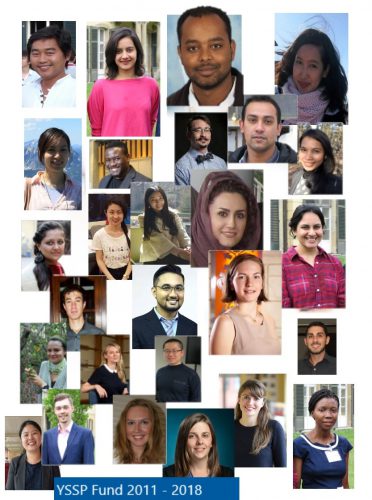
YSSP Fund recipients from 2011 to 2018
The 27 fellows smiling at you from the photograph are all part of the IIASA global network of system thinkers thanks to the Young Scientists Summer Program (YSSP) Fund. The YSSP Fund accepts donations from the IIASA community and directs the proceeds to support young scholars who are not eligible to receive a stipend from an IIASA National Member Organization.
The IIASA experience has had a profound influence on the lives of previous recipients, and has brought them closer to answering some of their most pertinent research questions. J. Luke Irwin (2018 YSSP Fund), for example, was able to explore which jobs and skills are the least automation resilient and how policymakers and academic institutions should address future unemployment caused by automation. Another previous beneficiary of the fund, Diana Erazo (2016 YSSP Fund), looked at the transmission dynamics of Chagas disease – one of the most neglected tropical diseases in Latin America – and the most efficient strategies to contain it.
Since its inception in 2011, the YSSP Fund has opened the IIASA door to 27 young researchers from Ethiopia, Thailand, India, China, Colombia, Brazil, and many other countries. All these scholars have since become an important part of the IIASA worldwide network, enriching the institute’s research portfolio and planting the seeds of their newly acquired systems analysis expertise in their home countries.
This bridge-building and door-opening capacity of the YSSP Fund is what inspires many members of the IIASA family to support it every year. Ever since I was appointed as development officer at IIASA in 2014, I have been privileged to accept donations from former IIASA directors, eminent researchers, and renowned experts in a variety of fields. We are all united in our belief that supporting the YSSP Fund is a great investment in future generations of researchers and an important token of trust in IIASA and its flagship capacity-building program.
Many of our alumni donors are former YSSP fellows, who appreciate the impact the program has had on their careers. One of them is Petr Aven, who was part of the first YSSP cohort in 1977 and still remembers this experience as the best time of his life. Some of our alumni, who were themselves recipients of the YSSP Fund scholarship, see it as their duty and privilege to give back. One of our most distinguished donors, Dr. Roger Levien, former director of IIASA and the founder of the YSSP, hopes that his donations will help build a bridge between IIASA and Pardee RAND Graduate School, of which he is an alumnus as well. The motivation behind our most recent pledge from Professors Jyoti and Kirit Parikh is to expose young minds to systems analysis and to promote research-based policymaking.
After the annual fundraising campaign is over and the IIASA network lives up to the challenge for yet another year, I find it very gratifying to be able to channel the support coming from the IIASA community to the YSSP Fund recipients. My favorite time of the year is June when I get to meet the lucky recipients of the scholarships, learn all about their plans and ambitions for the summer at IIASA, and see how motivated they are to make the most of their time at the institute.
However, the real satisfaction kicks in when I see the YSSP Fund fellows thrive in their post-IIASA careers. With immense support from our alumni officer and the Communication Department, we take great pride in sharing their successes with the IIASA worldwide community. We see it as a token of gratitude to both the donors, who opened the IIASA door to them, as well as to their IIASA supervisors, who generously shared their expertise and continue to mentor them after their summer at the institute is over.
Speaking of successes, Gbemi Samuel (2017 YSSP Fund), the first Nigerian to ever participate in the program has recently published a well-received article in the Journal of African Population Studies describing her research on estimating how many children under five could be prevented from dying if women in Nigeria used cleaner fuels to cook their family meals. Lu Liu, a 2016 YSSP Fund recipient published her first-authored paper in Environmental Research Letters and had a poster presentation at the AGU Fall Meeting in Washington D.C. We are also very proud of Zhimin Mao’s (2015 YSSP Fund) post-IIASA career, starting from her IIASA Peccei Award in 2015 and leading up to her current position at the World Bank. We can hardly wait to boast about the successes and accomplishments of our 2018 YSSP Fund fellows and hope they will stay in touch.
Every donation to the YSSP Fund goes a long way. Help us close more funding gaps this summer and support the next generation of system thinkers!
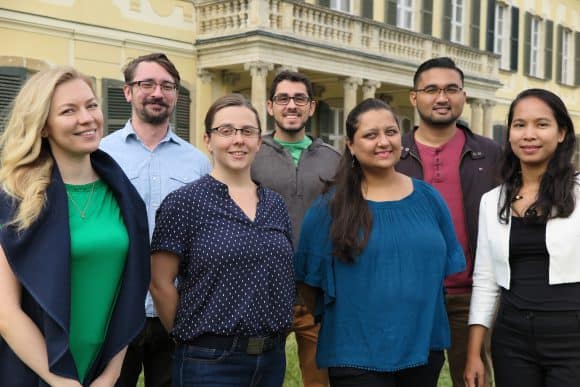
2018 YSSP Fund recipients: (L-R) Ekaterina Antsygina, Luke Irwin, Sara Turner, Fabio Diuana, Ankita Srivastava, Muhammad Nurariffudin, Fumi Harahap
Support the 2019 YSSP Fund
Note: This article gives the views of the author, and not the position of the Nexus blog, nor of the International Institute for Applied Systems Analysis.
Jan 11, 2019 | Alumni, Energy & Climate, IIASA Network, Water, Women in Science, Young Scientists
By Lu Liu, postdoctoral research associate at Rice University, USA and IIASA YSSP 2016 participant
I have been attending the American Geophysical Union (AGU) Fall Meeting since 2013 when I was working with the Joint Global Change Research Institute. Ever since then, the AGU Fall Meeting has become one of my most anticipated events of the year where I get to share my research and make new friends.
The first time I attended the AGU Fall Meeting, I was overwhelmed with the size and scale of this conference. There are more than 20,000 oral and poster presentations throughout the week, and the topics cover nearly 30 different themes, from earth and space science, to education and public affairs. I was thrilled to see my research being valued and discussed by people from various backgrounds, and I was fascinated by other exciting research and rigorous ideas that emerged at the meeting.

Lu Liu at 2018 AGU poster session
At this year’s AGU, I presented my poster Implications of decentralizing urban water supply infrastructure via direct potable water reuse (DPR) in a session titled Water, Energy, and Society in Urban Systems. In a nutshell, my poster presents a quantitative model that evaluates the cost-benefits of direct potable water reuse in a decentralized water supply system. The concept of decentralization in an urban water system has been discussed in previous literature as an effective approach towards sustainable urban water management. Besides the social and technical barriers in implementing decentralization, there is a lack of analytical and computational tools necessary for the design, characterization, and evaluation of decentralized water supply infrastructure. My study bridges the gap by demonstrating the environmental and economic implications of decentralizing urban water infrastructure via DPR using a modeling framework developed in this study. The quantitative analysis suggests that with the appropriate configuration, decentralized DPR could potentially alleviate stress on freshwater and enhance urban water sustainability and resilience at a competitive cost. More about this research and my other work can be found here: https://emmaliulu.wixsite.com/luliu.
At the AGU Fall Meeting, I engaged in various opportunities to reconnect with old colleagues and build new professional relationships. What’s better than running into my former YSSP supervisors and IIASA colleagues after two years since I left the YSSP? Although my time spent at IIASA was short, I hold IIASA and the YSSP very close to my heart because the influence this experience has had on my professional and personal life is profound.
I will continue to attend the AGU Fall Meeting for the foreseeable future. After all, we all want to feel a sense of belonging and acceptance in a community, and I am glad I already found mine.
Note: This article gives the views of the author, and not the position of the Nexus blog, nor of the International Institute for Applied Systems Analysis.










You must be logged in to post a comment.